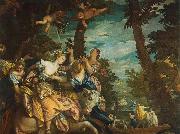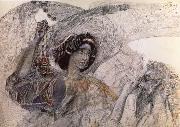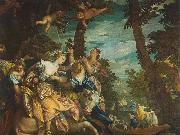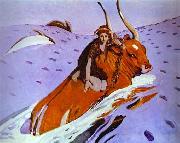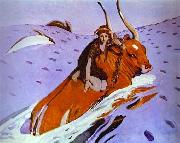Wholesale Oil Painting No Minimum |
|||||||||||
|
|
|||||||||||

|
|||||||||||
|
|
|
||||||||
Paolo VeroneseItalian Mannerist Painter, ca.1528-1588 Italian painter and draughtsman. With Titian and Tintoretto he makes up the triumvirate of great painters of the late Renaissance in Venice. He is known as a supreme colourist and for his illusionistic decorations in both fresco and oil. His large paintings of biblical feasts executed for the refectories of monasteries in Venice and Verona are especially celebrated. He also produced many altarpieces, history and mythological paintings and portraits. His compositional sketches in pen, ink and wash, figure studies in chalk, and chiaroscuro modelli and ricordi form a significant body of drawings. |
||||||||
|
|
||||||||
The Rape of Europe
The Rape of Europe Painting ID:: 44395 |
1580
Oil on canvas,
240 x 303 cm 1580 Oil on canvas, 240 x 303 cm |
|||||||
|
|
||||||||
|
|
||||||||
|
|
The Rape of Europe
The Rape of Europe Painting ID:: 49127 |
mk193
1910
Tempera on canvas
71x98cm
mk193 1910 Tempera on canvas 71x98cm |
||||||
|
|
||||||||
|
|
||||||||
|
|
The Rape of Europe
The Rape of Europe Painting ID:: 63019 |
1580 Oil on canvas, 240 x 303 cm Sala di Anticollegio, Palazzo Ducale, Venice Painted between 1576 and 1580, the picture was reported by Zanetti as hanging in its present place in 1755; it was removed by the French in 1797 and taken to Paris, where it was restored and altered. It represents the mythical rape of Europa by Jupiter in the guise of a bull, as she prepares to mount on the god's back with the help of her maids. The action unfolds towards the right in the manner of a stage sequence, in successive scenes down to the final plunge into the waves of the sea. The composition clearly marks the moment of transition from Renaissance Classicism to seventeenth-century Arcadia. The sumptuous decor and rich colouring were to provide a seminal experience for subsequent Baroque painting. Thus the painting initiates the exaltation of the ruling class through court mythology intended to rekindle the aristocracy's love of pomp and circumstance by allegories with which it could identify itself. *** Keywords: ************* Artist: VERONESE, Paolo Painting Title: The Rape of Europe , 1551-1600 Painting Style: Italian , , mythological 1580 Oil on canvas, 240 x 303 cm Sala di Anticollegio, Palazzo Ducale, Venice Painted between 1576 and 1580, the picture was reported by Zanetti as hanging in its present place in 1755; it was removed by the French in 1797 and taken to Paris, where it was restored and altered. It represents the mythical rape of Europa by Jupiter in the guise of a bull, as she prepares to mount on the god's back with the help of her maids. The action unfolds towards the right in the manner of a stage sequence, in successive scenes down to the final plunge into the waves of the sea. The composition clearly marks the moment of transition from Renaissance Classicism to seventeenth-century Arcadia. The sumptuous decor and rich colouring were to provide a seminal experience for subsequent Baroque painting. Thus the painting initiates the exaltation of the ruling class through court mythology intended to rekindle the aristocracy's love of pomp and circumstance by allegories with which it could identify itself. *** Keywords: ************* Artist: VERONESE, Paolo Painting Title: The Rape of Europe , 1551-1600 Painting Style: Italian , , mythological |
||||||
|
|
||||||||
Valentin SerovRussian Impressionist Painter, 1865-1911 |
||||||||
|
|
||||||||
|
|
The Rape of Europe
The Rape of Europe Painting ID:: 83851 |
The Rape of Europe. 1910. Oil on canvas
cjr The Rape of Europe. 1910. Oil on canvas cjr |
||||||
|
|
||||||||
Valentin SerovRussian Impressionist Painter, 1865-1911 |
||||||||
|
|
||||||||
|
|
The Rape of Europe
The Rape of Europe Painting ID:: 87722 |
1910. Oil on canvas. The Tretyakov Gallery, Moscow, Russia
cyf 1910. Oil on canvas. The Tretyakov Gallery, Moscow, Russia cyf |
||||||
|
|
||||||||
|
Valentin Serov Russian Impressionist Painter, 1865-1911 The Rape of Europe 1910. Oil on canvas. The Tretyakov Gallery, Moscow, Russia cyf |
||||||||
|
|
||||||||
|
Prev Next
|
||||||||
|
|
||||||||
|
Related Paintings to Valentin Serov :. |
||||||||
|
|
||||||||
|
CONTACT US |
